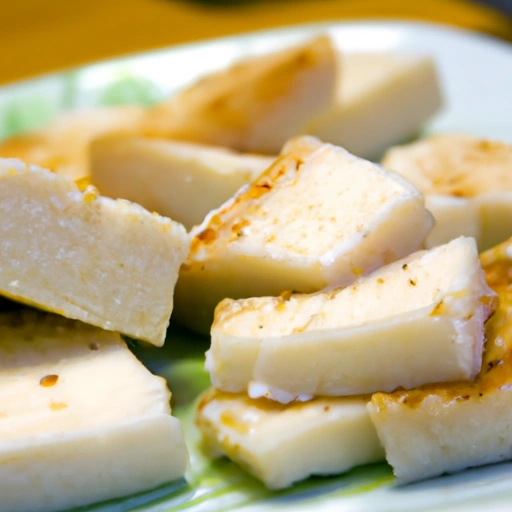Halloumi
Description

Halloumi is a semi-hard, unripened, brined cheese traditionally made from a mixture of goat's and sheep's milk, although nowadays it is often produced with cow's milk as well. Originating from Cyprus, Halloumi is renowned for its distinctive layered texture, salty flavor, and an exceptional ability to retain its shape when cooked, thanks to its high melting point. Halloumi is available in various sizes, typically ranging from 8 to 9 ounces (227 to 255 grams) and is often served grilled or fried.
Common uses
Halloumi is commonly used as a grilling cheese due to its high melting point. It is enjoyed as a snack, often accompanied by watermelon or used in salads, sandwiches, and various cooked dishes. Its robust texture and savory taste also make it a popular meat substitute in vegetarian and vegan recipes.
Nutritional value
Calories
Approximately 321 calories per 100 grams (3.5 oz).
Protein
Contains about 18 grams of protein per 100 grams (3.5 oz).
Fat
Roughly 25 grams of fat per 100 grams (3.5 oz), predominantly saturated fat.
Carbohydrates
Less than 1 gram of carbohydrates per 100 grams (3.5 oz), making it low-carb friendly.
Vitamins
A source of Vitamin A and B vitamins, particularly B12.
Minerals
Rich in calcium, providing about 70% of the recommended daily intake per 100 grams (3.5 oz), and also contains phosphorus and zinc.
Health benefits
Halloumi is rich in protein and calcium, which are essential for bone health and muscle function. The presence of B vitamins aids in energy metabolism and maintaining healthy skin and red blood cells.
Potential risks
Due to its high sodium and fat content, excessive consumption of Halloumi may increase the risk of cardiovascular disease. It should be consumed in moderation, especially by individuals with hypertension or a history of heart disease.
Common recipes
Halloumi is a versatile ingredient used in recipes like grilled halloumi salad, halloumi burgers, and halloumi skewers.
Cooking methods
The cheese can be grilled, fried, or baked without melting, making it suitable for a variety of cooking methods.
Pairing with other ingredients
Halloumi pairs well with fresh vegetables, fruits like watermelon and figs, as well as with a drizzle of olive oil and herbs such as mint or oregano.
Summary
Halloumi cheese is a distinctive and versatile ingredient beloved for its rich flavor and texture that can withstand high cooking temperatures. While it has numerous health benefits, it should be enjoyed in moderation due to its sodium and saturated fat content. Halloumi's adaptability in the kitchen makes it a favorite across cultures and an ideal choice for creative culinary exploration.